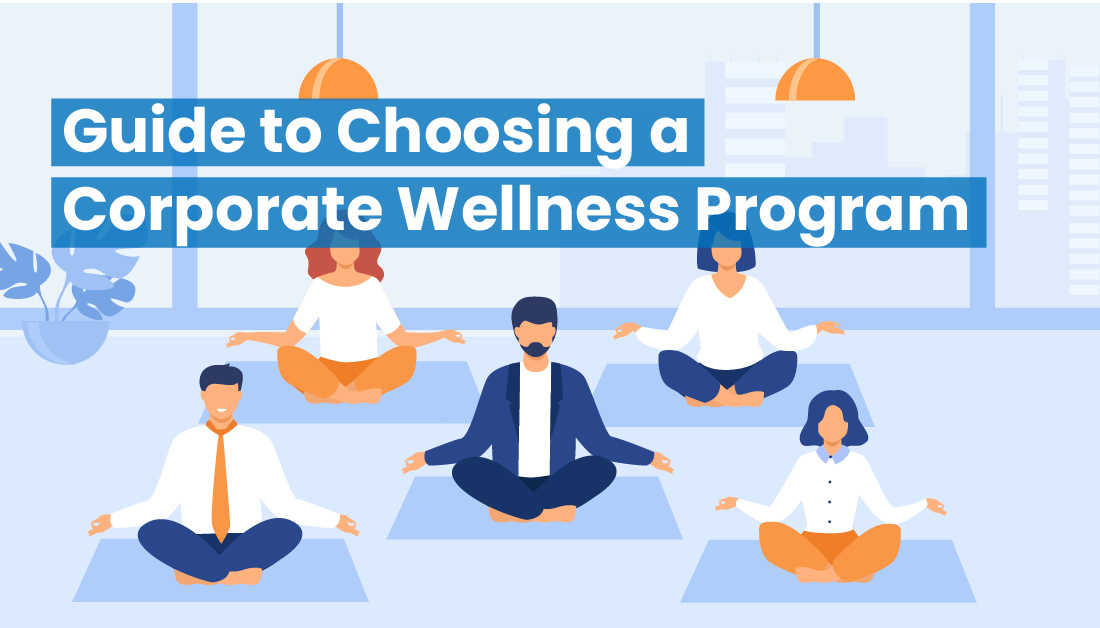Corporate wellness programs are designed to create a culture of health that supports employee well-being. With the right employee wellness program you can help your employees improve their health and decrease their health risks, while reducing your health care costs.
In fact, with the right approach, a workplace wellness program can improve employee satisfaction and can help your employees be more adaptable and productive, and decrease depression. Employees, more and more, are expecting their company to offer a wellness program. According to a survey by John Hopkins Bloomberg School of Public Health, almost 60% of employees think their employers should attempt to improve the health of their workers. And right now, more than 75% of employers offer some sort of wellness program for their employees.
The Cost of Unhealthy Employees
Yes, you want your employees to be happy, but you really want them to be healthy. One of the main reasons corporate wellness programs exist is to reduce health care costs.
Let’s take a look at the numbers. In the United States we’re not a very healthy bunch: 42% of adults are obese and 71% are either overweight or obese. Individuals that are overweight or obese are an increased risk for diabetes, stroke, heart disease and some cancers.
Poor worker health comes at a cost. A $575 billion a year cost. That amounts to 60 cents for every dollar employers spend on health care benefits, according to the Integrated Benefits Institute, a health research group.
The costs of obesity
- $190.2 Billion: The estimated annual health care costs of obesity-related illness. That’s 21% of annual medical spending. (Source)
- $8.65 Billion: Estimated cost of obesity-related work absences (Source)
- 36% higher: Medical costs attributed to obese and overweight adults are 36% higher than those of normal weight. (Source)
The Impact of Employee Wellness Programs
The good news is the right employee wellness program can help improve the health of your employees and improve your bottom line.
- 70% of employees enrolled incorporate wellness programs have reported higher job satisfaction compared to those not enrolled in the program (Aflac, 2019)
- 56% of employees had fewer sick days because of wellness programs (United Healthcare, 2018)
- 60% of respondents reported that workplace wellness programs reduced their organization’s health care costs (US Chamber, 2016)

7 Things to Consider When Selecting and Implementing a Corporate Wellness Program
Whether you’re just dipping your toes into the employee wellness world, looking to find a new wellness program vendor, trying to integrate with a new wellness platform, or outsourcing your well-being program, our guide to choosing a workplace wellness program can help you on your search.
Selecting and implementing a corporate wellness program isn’t an easy task. Our 7 step guide will help you prioritize and plan so you can select the program or wellness vendor that fits your needs.
1. Assess Your Needs
As we stated earlier, more than 60% of employees think their employer should play a role in improving their health. So it’s safe to assume your employees want you to offer a wellness plan. But what should that wellness plan look like? Naturally the first step is deciding what to look for in a wellness program.
Conduct Surveys
You need to do some legwork, and we’re not talking squats. You need to do research. Go directly to the source. If you want your employees to engage in a wellness program – it will help knowing what they actually want. Conduct a survey of your employees to determine what their wellness needs and interests.The CDC has great resources to assist you with creating and conducting surveys.
Health Readiness Index
While you want to know what your employees want, you should know what your workplace needs. This is where a workplace health survey comes in. A workplace health assessment gathers information about the factors that support or hinder the health of your employees and can help you address them. It helps paint a picture of the health of your workplace and a necessary first step before you start developing goals. At incentaHEALTH, we perform a Health Readiness Index (HRI) annually for each of our clients, providing a location-by-location analysis of what’s working, and what can be improved across your organization.
Use the Data You Have
In addition to conducting surveys and health assessments, it’s worthwhile to look at what information you already have. Have you run wellness programs in the past? What has worked? What hasn’t worked? What are the needs of your employees? What health metric data do you have? This can help guide you to finding a wellness program that fits your organization.
2. Set Goals
Use the information you’ve gathered to set your organizational wellness goals and objectives. For many organizations, a top goal is to improve worker health to help reduce healthcare costs. Other goals may be improving employee satisfaction and retention, or reducing workplace stress.
Consider both short-term and long-term goals and how you’re going to measure them. For example, if your goal is to reduce your healthcare costs. Your objective may be to reduce the obesity rate by 5% in two years.
3. Get Management Support
Obtaining the support of management is key to the success of any new program or policy, including a wellness program. It is crucial for obtaining and maintaining funding support. It also gives you the opportunity to ensure your wellness program aligns with any other overarching organizational goals.
To obtain buy-in from key individuals in your organization, you need to clearly state the value of a wellness program to your bottom line and how it can improve your organization and its employees.

4. Establish a Budget + Find Funding Sources
You’ve done your research. You know what your employees want and need. Management is on board. Now we need to talk numbers. It is time to establish a wellness program budget. You need to determine all potential costs, as well as potential ways you may be able to fund it.
You may want to consider potential funding sources such as your health insurance carrier. Oftentimes wellness program costs are included in your premiums, or they may offer ‘wellness dollars’ for you to spend on your employees’ wellness.
The health of your employees is worth investing in. A research study published in Preventive Medicine projected a 16:1 ROI, saving the insurance payer an estimated $47.3 million over the study population’s lifetime, based on the BMI improvements of incentaHEALTH’s members.
5. Select and Prioritize Program Features
By this point, you should have a clear idea of what you’re hoping to accomplish with your wellness program. This should help you narrow in on the types of programs and platforms that can help you accomplish your goals.
Here are a few things to consider:
Sustainability – Your wellness program shouldn’t be a one-time biggest loser type fitness challenge, or a one-off initiative. You need to think long term. When developing a wellness program or selecting a new wellness vendor, you want something long-term, not a quick fix.
Implementation – How involved does your organization want to be? Or how involved can you be? Are you wanting to be hands on, or would like a turn-key program that doesn’t require much time commitment on your end?
Types of Programs – There are numerous types of wellness programs. What are you looking for? Look back to your goals and select the program features that best align. Here are a few ideas:
- Stress Management programs
- Weight loss programs
- Health Screenings
- Exercise programs
- Nutrition education
- Smoking cessation programs
- Diabetes Prevention programs

6. Fun Factor and Incentives
You’ve spent all this time researching, gaining buy-in and funding, and selecting program features – but how are you going to get your employees involved? Oftentimes that engagement piece is overlooked.
Fun Factor
No one wants to be bored with statistics or health metrics – they want something new and exciting! When implementing your new wellness initiative you need to think of the ‘fun factor.’ Gamification is popular with many wellness programs and apps and makes healthy eating and active living more fun.
Incentives
While the program itself will help your employees adopt healthy behaviors, how are you going to get them to participate and continue engaging? Wellness incentives and rewards can be an effective tool to not only increase participation, but also can be used as a motivational tool for continued engagement and adherence. According to a study, incentives are associated with higher participation rates in wellness programs by about 20%.
At incentaHEALTH we have found leading with a fun, friendly message and using gamification through our app, challenges and reward mechanisms not only leads to higher engagement, but also helps with retention.
7. Reporting and Program Evaluation
You will want to evaluate the effectiveness of your wellness program. How will you measure your program’s success? Look back at your goals. What information will you need to measure, or need access to in order for you to evaluate your goals. If you’re working with a wellness vendor, how often will you receive reporting, what information will you have access to and is there an additional cost associated with that. At the bare minimum, you will want to measure how many people are engaging with your well-being program and the impact it is having.
At incentaHEALTH we provide each client with a visual wellness analytics dashboard that allows for point-and-click analysis of program performance.
Conclusion
We hope our step-by-step guide will give you the tools to select the right worksite wellness program that will work for your employees and align with your company culture. We invite you to connect with one of our employee wellness specialists for a complimentary session to chat about your wellness goals and determine the types of programs that will work best for your organization.




